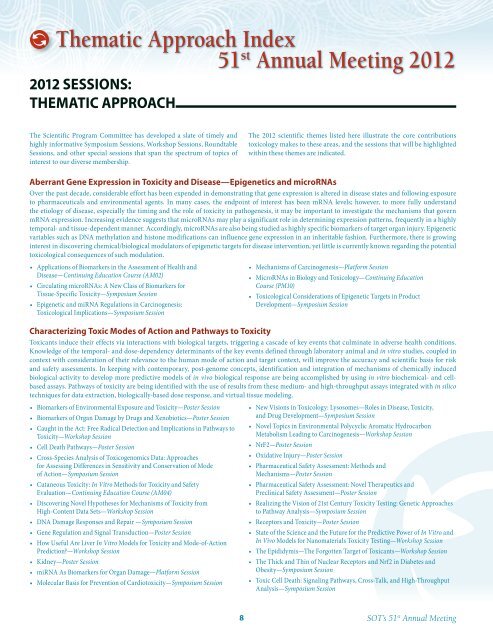51st Annual Meeting & ToxExpo - Society of Toxicology
51st Annual Meeting & ToxExpo - Society of Toxicology
51st Annual Meeting & ToxExpo - Society of Toxicology
Create successful ePaper yourself
Turn your PDF publications into a flip-book with our unique Google optimized e-Paper software.
Thematic Approach Index<br />
51 st <strong>Annual</strong> <strong>Meeting</strong> 2012<br />
2012 Sessions:<br />
Thematic Approach<br />
The Scientific Program Committee has developed a slate <strong>of</strong> timely and<br />
highly informative Symposium Sessions, Workshop Sessions, Roundtable<br />
Sessions, and other special sessions that span the spectrum <strong>of</strong> topics <strong>of</strong><br />
interest to our diverse membership.<br />
The 2012 scientific themes listed here illustrate the core contributions<br />
toxicology makes to these areas, and the sessions that will be highlighted<br />
within these themes are indicated.<br />
Aberrant Gene Expression in Toxicity and Disease—Epigenetics and microRNAs<br />
Over the past decade, considerable effort has been expended in demonstrating that gene expression is altered in disease states and following exposure<br />
to pharmaceuticals and environmental agents. In many cases, the endpoint <strong>of</strong> interest has been mRNA levels; however, to more fully understand<br />
the etiology <strong>of</strong> disease, especially the timing and the role <strong>of</strong> toxicity in pathogenesis, it may be important to investigate the mechanisms that govern<br />
mRNA expression. Increasing evidence suggests that microRNAs may play a significant role in determining expression patterns, frequently in a highly<br />
temporal- and tissue-dependent manner. Accordingly, microRNAs are also being studied as highly specific biomarkers <strong>of</strong> target organ injury. Epigenetic<br />
variables such as DNA methylation and histone modifications can influence gene expression in an inheritable fashion. Furthermore, there is growing<br />
interest in discovering chemical/biological modulators <strong>of</strong> epigenetic targets for disease intervention, yet little is currently known regarding the potential<br />
toxicological consequences <strong>of</strong> such modulation.<br />
• Applications <strong>of</strong> Biomarkers in the Assessment <strong>of</strong> Health and<br />
Disease—Continuing Education Course (AM02)<br />
• Circulating microRNAs: A New Class <strong>of</strong> Biomarkers for<br />
Tissue-Specific Toxicity—Symposium Session<br />
• Epigenetic and miRNA Regulations in Carcinogenesis:<br />
Toxicological Implications—Symposium Session<br />
• Mechanisms <strong>of</strong> Carcinogenesis—Platform Session<br />
• MicroRNAs in Biology and <strong>Toxicology</strong>—Continuing Education<br />
Course (PM10)<br />
• Toxicological Considerations <strong>of</strong> Epigenetic Targets in Product<br />
Development—Symposium Session<br />
Characterizing Toxic Modes <strong>of</strong> Action and Pathways to Toxicity<br />
Toxicants induce their effects via interactions with biological targets, triggering a cascade <strong>of</strong> key events that culminate in adverse health conditions.<br />
Knowledge <strong>of</strong> the temporal- and dose-dependency determinants <strong>of</strong> the key events defined through laboratory animal and in vitro studies, coupled in<br />
context with consideration <strong>of</strong> their relevance to the human mode <strong>of</strong> action and target context, will improve the accuracy and scientific basis for risk<br />
and safety assessments. In keeping with contemporary, post-genome concepts, identification and integration <strong>of</strong> mechanisms <strong>of</strong> chemically induced<br />
biological activity to develop more predictive models <strong>of</strong> in vivo biological response are being accomplished by using in vitro biochemical- and cellbased<br />
assays. Pathways <strong>of</strong> toxicity are being identified with the use <strong>of</strong> results from these medium- and high-throughput assays integrated with in silico<br />
techniques for data extraction, biologically-based dose response, and virtual tissue modeling.<br />
• Biomarkers <strong>of</strong> Environmental Exposure and Toxicity—Poster Session<br />
• Biomarkers <strong>of</strong> Organ Damage by Drugs and Xenobiotics—Poster Session<br />
• Caught in the Act: Free Radical Detection and Implications in Pathways to<br />
Toxicity—Workshop Session<br />
• Cell Death Pathways—Poster Session<br />
• Cross-Species Analysis <strong>of</strong> Toxicogenomics Data: Approaches<br />
for Assessing Differences in Sensitivity and Conservation <strong>of</strong> Mode<br />
<strong>of</strong> Action—Symposium Session<br />
• Cutaneous Toxicity: In Vitro Methods for Toxicity and Safety<br />
Evaluation—Continuing Education Course (AM04)<br />
• Discovering Novel Hypotheses for Mechanisms <strong>of</strong> Toxicity from<br />
High-Content Data Sets—Workshop Session<br />
• DNA Damage Responses and Repair —Symposium Session<br />
• Gene Regulation and Signal Transduction—Poster Session<br />
• How Useful Are Liver In Vitro Models for Toxicity and Mode-<strong>of</strong>-Action<br />
Prediction?—Workshop Session<br />
• Kidney—Poster Session<br />
• miRNA As Biomarkers for Organ Damage—Platform Session<br />
• Molecular Basis for Prevention <strong>of</strong> Cardiotoxicity—Symposium Session<br />
• New Visions in <strong>Toxicology</strong>: Lysosomes—Roles in Disease, Toxicity,<br />
and Drug Development—Symposium Session<br />
• Novel Topics in Environmental Polycyclic Aromatic Hydrocarbon<br />
Metabolism Leading to Carcinogenesis—Workshop Session<br />
• NrF2—Poster Session<br />
• Oxidative Injury—Poster Session<br />
• Pharmaceutical Safety Assessment: Methods and<br />
Mechanisms—Poster Session<br />
• Pharmaceutical Safety Assessment: Novel Therapeutics and<br />
Preclinical Safety Assessment—Poster Session<br />
• Realizing the Vision <strong>of</strong> 21st Century Toxicity Testing: Genetic Approaches<br />
to Pathway Analysis—Symposium Session<br />
• Receptors and Toxicity—Poster Session<br />
• State <strong>of</strong> the Science and the Future for the Predictive Power <strong>of</strong> In Vitro and<br />
In Vivo Models for Nanomaterials Toxicity Testing—Workshop Session<br />
• The Epididymis—The Forgotten Target <strong>of</strong> Toxicants—Workshop Session<br />
• The Thick and Thin <strong>of</strong> Nuclear Receptors and Nrf2 in Diabetes and<br />
Obesity—Symposium Session<br />
• Toxic Cell Death: Signaling Pathways, Cross-Talk, and High-Throughput<br />
Analysis—Symposium Session<br />
8<br />
SOT’s 51 st <strong>Annual</strong> <strong>Meeting</strong>
















